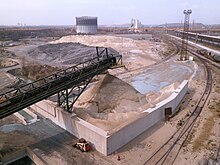Slag sand
The metallurgical or slag sand is created by granulating liquid blast furnace slag with water and / or air. It is a fine-grained (<5 mm), glassy by-product of pig iron production in the blast furnace . In 2005, approx. 5.7 million t of slag sand was produced in Germany.
Slag sand consists of approx. 30–45% CaO, 30–45% SiO 2 , 5–15% Al 2 O 3 , 4–17% MgO, 0.5–1% S and traces of other elements. The composition varies depending on the materials used in the blast furnace ( Möller ). Its pure density is about 2.9 g / cm 3 . Grains of blast furnace slag can be very dense, but also very porous. Compared to mineral substances, they are often relatively difficult to grind. Blast furnace slag usually also contains fine needle-shaped glass particles, aerosols with blast furnace slag are therefore harmful to health and blast furnace slag can not be used without other binding agents.
Due to its physical and chemical properties, ground blast furnace slag has been used in the cement industry for over 100 years as the main component of so-called Portland slag and blast furnace cements (CEM II / S and CEM III according to EN 197). These cements have some special properties. Concretes with these cements are z. B. particularly resistant to the attack of chemicals and road salt as well as to the alkali-silica reaction . In addition, with the same fineness , the hydration of the cement is usually slower than with normal Portland cements . This means that the heat of hydration released is lower, which is particularly important in the case of massive concrete structures such as B. bridge piers, dams, large foundations, sluices, etc. is advantageous because on the one hand crack formation due to constrained stresses due to thermal expansion is prevented and on the other hand, the generation of reaction heat is reduced, which leads to "burning" (loss of water and thereby the Hydration, the result is an only partially hardened concrete) of the concrete. Visually, concretes with cements containing slag sand stand out due to their light gray, almost white color. The production of cements containing slag sand requires significantly less primary energy and causes significantly fewer CO 2 emissions ( greenhouse effect ) than the production of Portland cement.

